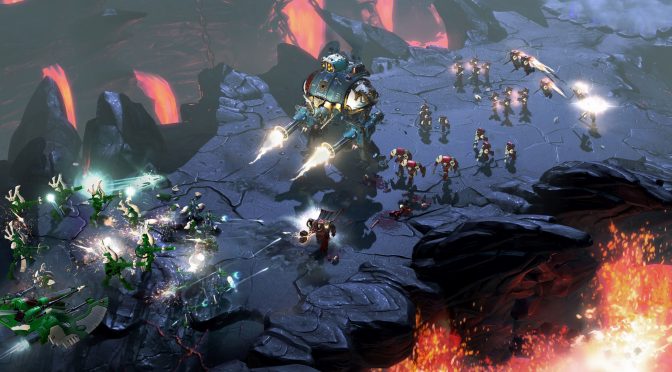The Warhammer 40K setting (originally a table-top game born in 1987) is one of those universally revered things; even if it’s not your cup of tea, you have to respect its history, its character, the fans, the legacy. That makes it extra embarrassing for pretty much everyone when something awkward happens or when there are mixed receptions due to varying expectations.
Relic’s first Dawn of War (2004) was a strategy game with large, free-roaming maps, huge armies and pretty standard, swarming tactics. The second game introduced small-scale skirmishes, fewer (but more powerful) units, RPG elements and tactical mechanisms like cover. This year’s Dawn of War III does an awkward shift to emphasize multiplayer games, creating a tactically simplified campaign that favors online play and that merely serves as an introduction to the multiplayer component.
Depending on who you ask, this can very well be the game’s greatest fault. The campaign feels uninspired and predictable on the narrative side while its level design fails to make full use of the various race (and map) characteristics. At its heart, Dawn of War III does not deviate far from some basic design pylons; there are three playable classes locked in never-ending war, each with its own characteristics. The Orks favor brute strength and numbers and can use scrap scattered along the map to upgrade themselves. They’re also the comedic element of the game, yammering like drunk bums from London’s East End (this is considered canon and worshipped by fans, but it always sounded silly to me personally). The Eldar are the space elves of the setting and rely on their portal-technology to move quickly around the map. Finally, the awe-inspiring Space Marines are those tough bastards, the armored crusaders that show that being the good guy does not necessarily make you a wimp. Unfortunately, each map changes the playable faction and this constant rotation does not leave you space to become attached to any of them. Those three basic factions are welcome of course, but more would have been better; Warhammer 40K features many races like the Necrons, Chaos, etc and their absence is felt. What will be worse, however, is if the horrible DLC machine starts churning these races out in the weeks to come.
Before you know it, the 17 straightforward missions of the campaign will be over and you will have to make your way to the brutal multiplayer component. The multiplayer mode takes direct hints from basic MOBA elements: there’s a three-layered defense around your core and aside from expanding and capturing, the main responsibility falls upon the shoulders of Hero units, each with specific talents and unlockable upgrades. Be warned: the learning curve is somewhat steep as you have to manage base, resources, army and Elite units at the same time.
I have nothing against the MOBA genre (except perhaps the silliness of the generic acronym); I have actually played my share of different games and still manage to play a quick match every day. But these games are tailor-made, built from the ground up and dedicated to a specific kind of mentality, rhythm, constant rebalancing, culture and spirit. Even if we do accept that the whole franchise of Dawn of War has decided to shift dramatically its focus and be reborn into an esports major player, that would be actually fine… if it was done in a methodical way. That would mean broad community support, awareness marketing, rich content and infrastructure, tournaments and teams. Alas, the multiplayer feature of Dawn of War III despite being the focus of this new mindset, feels limited: there’s only one mode, a handful of available maps and (above all) a divided community that has no idea how to react to this new era of the franchise.
Finally, some closing remarks regarding graphics and audio. There’s a charming level of detail in the unit design (particularly if you dive into the traditional, fan-favorite Army Painter), but otherwise, the game’s graphics are a mixed bag. When you zoom out, you can’t see a large enough portion of the battlefield. When you zoom in, you’ll wish you hadn’t. It’s not that Dawn of War III is an ugly game- far from it. There’s enough color and personality for a Warhammer game, but technically, it’s not exactly cutting edge and that becomes more evident when you zoom in and notice a certain chunky blandness in the environment. And above all (and this is my own personal problem with Dawn of War III) the graphics are certainly not that gorgeous to justify the outrageous hardware requirements. A few minutes after starting the game (on a up-to-date rig with: Win10, i7 6700,16GB RAM, R9 390 GPU), the PC started growling in pain, like never before. No other games have stressed my machine that much: CPU/GPU temperatures climbed to 92C/95C, respectively. Knocking down all settings from Recommended to High, to Med and then to Low, fixed the problem, but this not the ideal solution. To be fair, despite my issues in the graphics area, the exact opposite can be said about the sound design, which features awesome effects and a chilling, doom-evoking soundtrack.
Dawn of War III certainly has its moments and is a somewhat fun game if you limit your expectations. For me personally, the ludicrous effect on my hardware, the forced multiplayer component and the mildly interesting storyline, it left me sadly unimpressed. As for the rest of you, the main criterion is (unfortunately) not if you are a Warhammer or even an RTS fan, but if you generally like multiplayer matches more than story-based campaigns.







